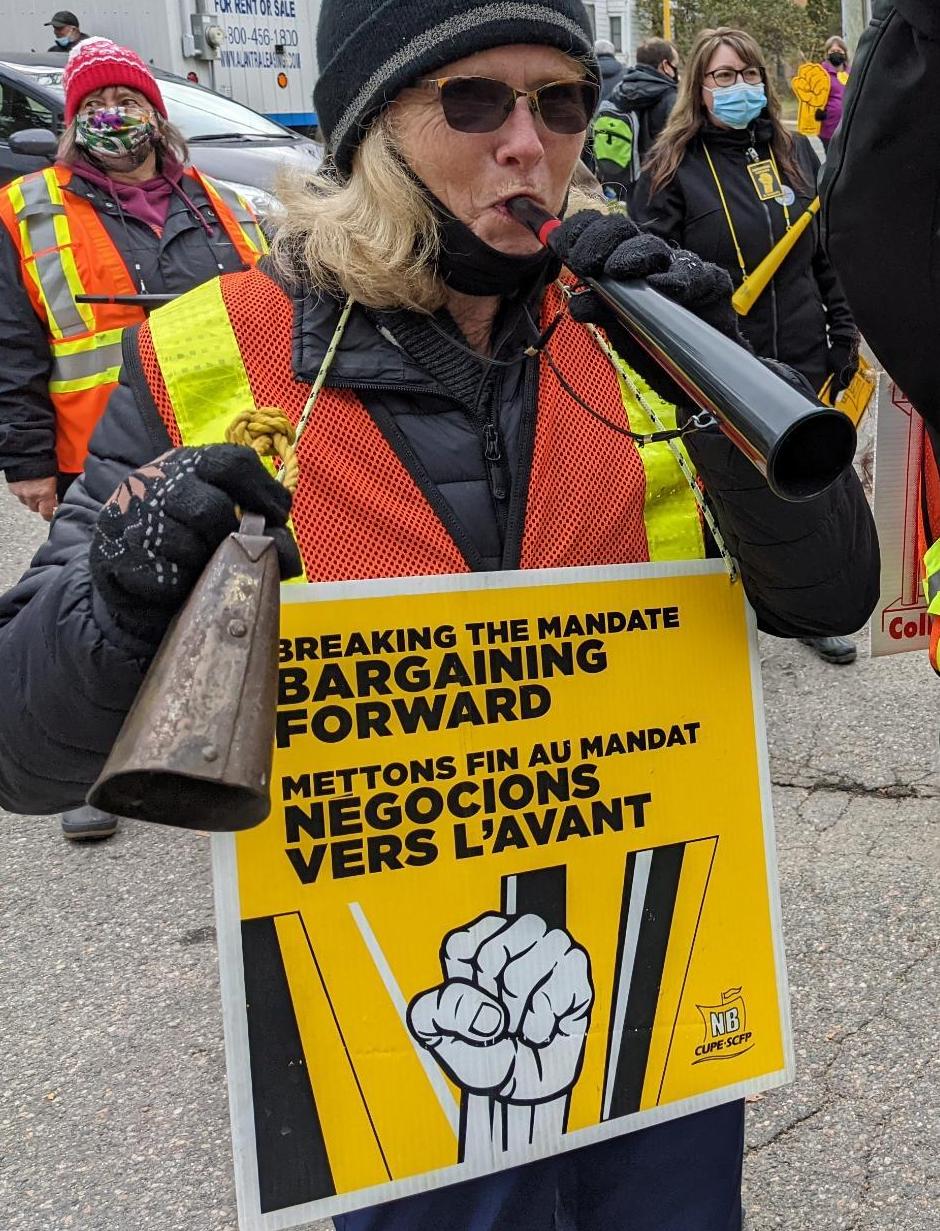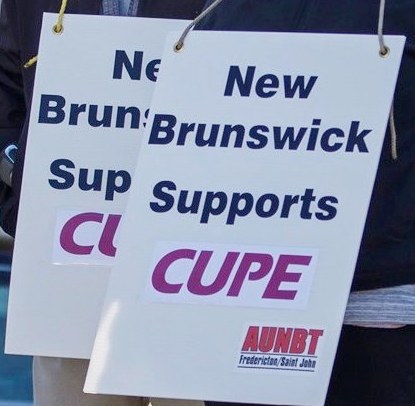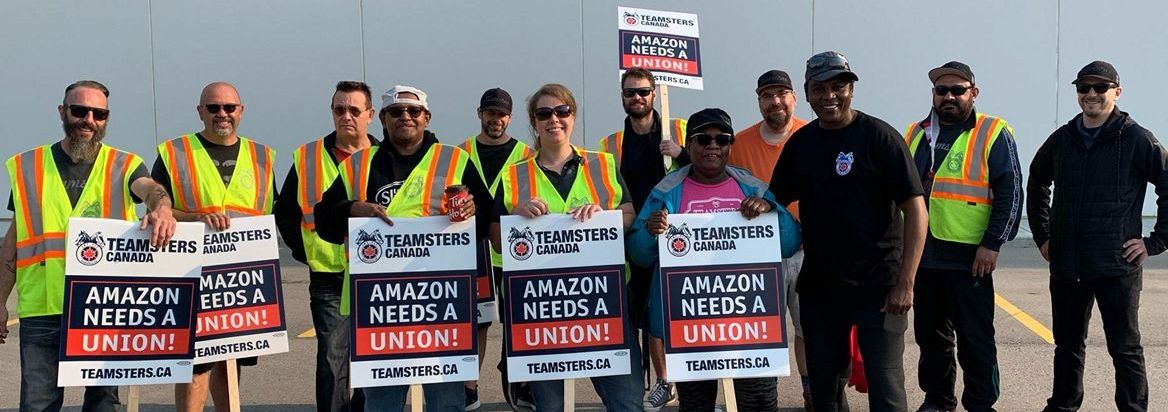|
November 17, 2021 - No. 108
Defending the Public Interest by
Upholding Workers' Rights
Public Sector Workers Reach Tentative
Agreement with New Brunswick Government

Alberta
• Alberta Amazon Plants
Apply for Union Certification
- Peggy Morton
• For Your Information:
Union Certification in Alberta
Defending the Public Interest by
Upholding Workers' Rights
On November 13, the Canadian Union of Public
Employees-New
Brunswick (CUPE NB) announced that a tentative
agreement has been
reached between the eleven union locals on the
centralized bargaining
team and the provincial government. The eleventh
local joined the
original ten when the Alcool NB Liquor (ANBL)
workers voted
strongly in favour of strike action on November
9. Those workers were
scheduled to strike November 16, but have
reached a tentative agreement
with ANBL on non-monetary issues.
 The CUPE workers
went on strike on October 29 for wages they deem
acceptable and essential to solving the
recruitment and retention
problem facing public services. They were also
opposed to the
government's demands for concessions from
workers in two education
locals, to accept the conversion of their
defined benefit pension plan
into a
shared risk plan in which pension benefits can
be cut if the plan is
declared underfunded. These 22,000 workers
include road maintenance and
park workers, correctional officers, social
workers, court reporters,
laundry workers, bus drivers and custodians in
schools, education
assistants, patient care workers and food and
environmental service
workers in hospitals. The CUPE workers
went on strike on October 29 for wages they deem
acceptable and essential to solving the
recruitment and retention
problem facing public services. They were also
opposed to the
government's demands for concessions from
workers in two education
locals, to accept the conversion of their
defined benefit pension plan
into a
shared risk plan in which pension benefits can
be cut if the plan is
declared underfunded. These 22,000 workers
include road maintenance and
park workers, correctional officers, social
workers, court reporters,
laundry workers, bus drivers and custodians in
schools, education
assistants, patient care workers and food and
environmental service
workers in hospitals.
In its press release, CUPE NB announced that
the tentative
wage agreement will be submitted to the members of each local
later this week.
On the issue of the employer's demand for concessions on pensions,
both locals
have reached a Memorandum
of Understanding
with the government which will also be submitted to the membership
later this
week. Voting results are to be announced at a CUPE press
conference on Friday,
November 19 at 11:00 am.
Meanwhile,
workers
have returned to work and the government has reopened the
schools it had closed
as a provocative tactic to try to turn families against striking
workers,
suddenly imposing e-learning. It had locked out striking
education workers,
accusing them of making teaching impossible at school. This
tactic failed
miserably, with parents strongly denouncing that tactic and
expressing their
support for the striking workers.
In
the meantime the union is going forward with its
lawsuit against the
government with regard to the November 5
emergency order announced by
the Minister of Justice and Public Safety that
forced health care
workers back to work, using the powers under the
province's Emergency Measures Act.
A state of emergency was declared
on September 24 in response to rising COVID-19
cases and the government
accused the workers of threatening the health
and safety of the people.
The lawsuit argues that the order violated the
workers' right to
freedom of association and that the hefty fines
constitute "cruel and
unusual punishment," which contravenes the Canadian
Charter of
Rights and Freedoms.
 From the
beginning, the workers and people of New
Brunswick have
been calling for a solution to the public
service crisis that defends
the public interest by defending workers'
rights. They reject the
state's use of repression and criminalization of
workers which is shown
in the large and small actions across the
province, including mass
demonstrations that were amongst the largest in
the province's history. From the
beginning, the workers and people of New
Brunswick have
been calling for a solution to the public
service crisis that defends
the public interest by defending workers'
rights. They reject the
state's use of repression and criminalization of
workers which is shown
in the large and small actions across the
province, including mass
demonstrations that were amongst the largest in
the province's history.
In a conversation with Workers' Forum,
CUPE NB President
Steve Drost spoke of the overwhelming support of
New Brunswick workers
and residents in their fight for their rights:
"It was an amazing experience. It was very
difficult for the workers
who had to go on strike but as each day
progressed more and more of the
public got behind the workers. We felt it was
quite an attack by the
government to try and get the public to be upset
with the workers but
it seemed to backfire on them. People were able
to see though
their propaganda and they realized that these
workers were simply
fighting for their rights. We had a rally on
Friday, November 12, with
close to 2,000 people at the Legislature. There
were parents, students,
teachers, other union groups and other
professional associations who
joined us. The public support and the support of
other professions and
unions was growing on a daily basis. We felt
that we were able to find
a compromise that both parties can live with and
I am feeling good that
our members will feel they were well
represented."

Alberta
- Peggy Morton -

Locals 362 and 987 of Teamsters Canada have filed for certification to
represent workers at Amazon's "fulfillment centres" in Nisku (Edmonton)
and Calgary, both located near the city airports. Teamsters Local 362
filed for the Nisku warehouse on September 14 and Local 987 applied for
certification for the Calgary warehouse on October 19. Teamsters
launched the organizing campaign at the June 2021 Convention of the
International Brotherhood of Teamsters. Dozens of local unions are
engaged in organizing in both Canada and the U.S.
The applications for union certification at both
Alberta locations are
now before the Alberta Labour Relations Board
(ALRB). The applications
are at the consideration stage in which the ALRB
meets with the union
and the employer to determine if the
application has been properly made, and if so,
sets a date for a
Board-supervised representation vote.
Workers’ Forum
congratulates Locals 362 and 987 for their achievement in being the
first to file applications for union certification for Amazon
warehouses, or "fulfillment centres" as Amazon calls them.
State Support for Amazon's Union-Busting
Tactics
Anti-worker legislation introduced by the
United Conservative Party
(UCP) government in 2020 requires a
board-supervised vote even when a
majority of workers have signed union cards. It
gives the Alberta
Labour Relations Board six months, with
provisions for extensions, to
verify cards, hold a vote and make a final
determination. This
provides employers potentially months to spread
false information and
to threaten, intimidate, and bully workers and
single out organizers.
Workers in Calgary have reported that the
employer has held small
meetings to say they knew who had signed union
cards.
A representative of Teamsters Local 362 told Workers'
Forum that they remain very vigilant in
the face of Amazon's virulent anti-union
history.
The
union has filed unfair labour practices complaints concerning Amazon's
actions at both the Calgary and Nisku warehouses. Amazon has been
repeatedly found guilty of unfair labour practices in both Canada and
the U.S. but is allowed to carry on with impunity. Governments
criminalize workers and their collectives and impose enormous fines and
other unjust penalties for their actions in defence of their rights and
dignity, all carried out at lightning speed. But when the oligopolies
violate labour law, labour boards and courts operate at a snail's pace,
if at all. Governments justify these attacks on workers’ rights
on the grounds that private interests like Amazon are the creators of
wealth whose claims have to be met and the workers are a cost to be
kept in check.
Amazon's actions at its Bessemer, Alabama
facility where a
unionization vote was not successful are a good
example. The U.S.
National Labour Relations Board (NLRB) found
that Amazon interfered
with the unionization vote; it had a mailbox
installed to collect
ballots and distributed paraphernalia
encouraging employees to vote
against
organizing. An NLRB regional director's decision
on whether to order a
new vote is expected soon.
The NLRB reported that Amazon installed
security cameras overlooking
the mailbox, creating the impression that
employees were under
surveillance. A tent erected around the mailbox
adorned with a company
campaign slogan, while not enough on its own to
invalidate the vote,
amounted to electioneering that tainted the
election, the NLRB
found. Amazon distributed "vote no" pins and
other anti-organizing
paraphernalia to employees in the presence of
managers and supervisors,
and held mandatory meetings to try to influence
the vote, sent text
messages to workers and even displayed campaign
literature in bathroom
stalls. Pending a decision on a re-vote, Amazon
has also launched
a new aggressive anti-union campaign in
Bessemer, which includes
officials walking the warehouse floor asking workers
how they feel about a
union.

Amazon Workers Speak Out
Amazon workers, former and active, are speaking
out in their own
name to expose their brutal working conditions,
as well as Amazon's
union-busting tactics, and to defend their
rights and dignity. Amazon
is notorious for outrageous work quotas,
constant monitoring of every
move a worker makes, its high rate of serious
workplace injuries
and its negligence in protecting workers from
COVID-19.
 Former
Amazon workers from the Greater Toronto Area
(GTA) have spoken out
about how the company retaliated against workers
trying to organize a
union for drivers. Amazon uses sub-contractors
to deliver packages, an
arrangement that it has used to stop the workers
from organizing by
ending the contract with a company where the
workers have unionized. Former
Amazon workers from the Greater Toronto Area
(GTA) have spoken out
about how the company retaliated against workers
trying to organize a
union for drivers. Amazon uses sub-contractors
to deliver packages, an
arrangement that it has used to stop the workers
from organizing by
ending the contract with a company where the
workers have unionized.
"When
the company realized I had started to talk to the other drivers about
having a union, they started an anti-union campaign," a worker told the
Fifth Estate. "The company called an all-hands-on-deck meeting." The
company owner said that Amazon would cut off the company and give the
work to another company, the worker said. The worker was fired, and
even though the Ontario Labour Board ordered him reinstated, on his
return to work he was left sitting in the parking lot while his Amazon
badge remained deactivated.
Another worker explained that after 75 per cent
of the workers at
his company voted for a union, the company
declared bankruptcy after
Amazon gave the work to another company.
Workers have spoken out about the large and
repeated outbreaks of
COVID-19 at warehouses. Amazon was finally
forced to close its
Brampton, Ontario, Heritage Road facility by
public health authorities
after at least 600 workers were infected by
COVID-19. The warehouse was
in outbreak from October 2020 to March 2021.
Amazon fought
the order. Amazon's Nisku warehouse was in
outbreak status for a total
of five and a half months during the first year
of the pandemic, with
at least 100 cases, but was allowed to remain
open the entire time.
Amazon's actions clearly show that the oligarchs
who control such
empires consider workers to be disposable, and
how governments
facilitate their reckless disregard for the
well-being of their workers.
Another trick in union-busting is to make vague
announcements about
future improvements to wages and working
conditions. The day before the
application for union certification was filed
for the Nisku warehouse,
Amazon announced that it would raise the
starting hourly rate for its
"frontline" workers from around $17 to "up to"
$21.65. But
workers spoke out to say that they might end up
with an actual pay cut
because the bonus program, based on attendance
and sales numbers for
each facility, had been eliminated. What "up to"
means is anyone's
guess, and Amazon's suggestions that hiring more
staff would reduce
workloads is meaningless in the face of its
sky-high staff
turnover.
While
working conditions at Amazon's "fulfillment centres," and for workers
who deliver Amazon packages further deteriorated during the pandemic,
Amazon had record revenues and profit in 2020, with annual revenue up
38 per cent to U.S.$386 billion, a yearly increase of over U.S.$100
billion. Net profit for Amazon was up 84 per cent for the year as
compared to 2019 and the personal wealth of its founder and CEO, Jeff
Bezos, reached U.S.$206.9 billion, Forbes reported. These are blatant
examples that show that this huge deployment of productive forces
cannot be left in private hands that have control of the state and its
institutions.
Workers' Forum calls on everyone to
stand with the Amazon
workers for the success of their efforts to
organize and to uphold
their right to decide wages and working
conditions acceptable to them.

The Alberta Labour Relations Code was amended
by the United
Conservative Party (UCP) government in 2020 to
require a vote for all
union certifications. A union may apply for
certification for a unit once at least
40 per cent of the employees have signed cards
within the previous 90 days indicating their
support for the union
certification. A board-supervised vote is
required even when a majority
of workers have signed cards.
The Alberta Labour Relations Board (ALRB)
previously had the power
to certify a union without a vote in the case of
clear misconduct of an
employer -- for example, firing workers who were
identified as leaders in
the organizing drive. The UCP removed this
power. Instead of certifying
the union, the Board must order a new vote and
certify
without a vote "only if no other remedy or
remedies would be sufficient
to counteract the effects of the prohibited
practices."
On receiving an application, the Board conducts
an investigation to
determine that the applicant is a trade union,
the unit applied for is
an appropriate unit for collective bargaining,
the application is
timely, and that the union has the support of at
least 40 per cent of
employees in the unit.
The Board explains the investigation process as
follows: "When a
union files a certification application, a Board
officer conducts an
impartial investigation. The officer speaks to
the employer and the
union. The officer may also speak to individual
employees. The officer
requires the union and the employer to produce
records relating to the
application, such as employee and membership
lists. The officer then
writes a report outlining whether or not the
application meets the
Code's requirements for certification. This
report is presented to the
parties (who may object to some of all of its
findings) and a panel of
Board members. The panel conducts a hearing and
decides whether or not
the application meets the requirements of the
Code. If so, the panel
orders an employee vote. If a majority of the
employees voting vote in
favour of the union, the union is certified."
There is no time limit set for the Board to
conduct a vote.[1] The legislation states that "the Board shall
make its final decision
whether to grant the application for
certification no later than six
months after the date of the application",
although in "exceptional
circumstances," which are not defined, the
Chair of the ALRB can approve an extension
beyond six months.
Mandatory certification votes and extended
timelines for the Labour Board to call a vote gives employers the
opportunity for union-busting,
allowing employers to carry out campaigns of
intimidation and to spread
false information, including at sessions which
workers must attend. The
campaign at Amazon is taking place in the face
of all these
difficulties which governments who serve the
oligarchs have put in
place.
Note
1. Legislation enacted by the NDP in 2018
established a time limit
of 20 or 25 working days after an application
was filed for the Board
to make a decision, with a limited power of the
Chair to extend the
time limit. It also provided for certification
without a vote, but with
a high bar, requiring at least 65 per cent of
the workers, not a simple
majority, to sign union cards.

(To access articles
individually click on the black headline.)
PDF
PREVIOUS
ISSUES | HOME
Website: www.cpcml.ca
Email: office@cpcml.ca
|

